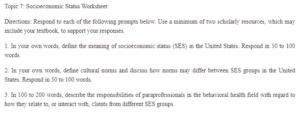Socioeconomic Status Worksheet
Define the meaning of socioeconomic status (SES) in the United States.
Socioeconomic status refers to a group or individual’s class or social standing. Socioeconomic status includes one’s income, financial security, educational attainment, and subjective perceptions of social class and social status. It can also encompass one’s quality of life attributes and the privileges and opportunities afforded to individuals in society. One’s status can be lower, upper, or middle class. According to the American Psychological Association (2017), socioeconomic status is a reliable and consistent predictor of various life outcomes, including psychological and physical health.
Define cultural norms and discuss how norms may differ between SES groups in the United States.
Cultural norms are the standards by which people live in the society. They are the shared rules and expectations that guide individuals’ behavior as they live and interact within social groups. Cultural norms may differ between various SES groups in the US. Research conducted in the US shows that high SES is linked to self-centric orientations. For instance, people with high SES backgrounds deliver increased self-expansion and self-confidence while manifesting reduced other-orientation like less conformity and prosocial behavior than those from low SES (Miyamoto et al., 2018). Furthermore, high SES implies better education, wealth, and prestigious jobs, enabling one to act as one wishes and not conform to society’s expectations.
Describe the responsibilities of paraprofessionals in the behavioral health field and how they relate to or interact with clients from different SES groups.
The essential responsibilities of paraprofessionals in behavioral health are assisting individuals with their daily activities, home care, maintenance, personal care, and transportation. They are to implement person-centered care and direct therapeutic interventions to help build socialization, community/daily living skills, and behavior management skills. Working with different SES groups can be overwhelming or frustrating for paraprofessionals who lack the confidence to manage clients from diverse backgrounds. There is the possibility that biases, stereotypes, or worldviews might get in the way of the paraprofessional’s responsibility. Individuals in other SES have varying values placed on them and face emotional and psychological issues. The paraprofessionals must assess, perceive and understand each patient as an individual without making generalizations. It is also imperative for them to show empathy and knowledge of the different SES groups to prevent discrimination or allow personal beliefs and feelings to get in the way they administer treatment to the clients. Research shows that counselors tend to rate clients with lower SES levels as experiencing more dysfunction, less successful counseling outcomes, increased goal disagreement regarding treatment, and lack of social support (Hawley, Leibert & Lane, 2016). Clients from lower SES levels are also generally perceived as having more severe problems, lacking motivation and effort, and being passive and apathetic. These things might not be accurate for all clients. Hence, There is the need for the paraprofessional needs to provide individualized care and assessment, generate trust, empathy, and understanding of one’s problems, and offer person-centered care.
References
American Psychological Association. (2017, July). Education and Socioeconomic Status. Retrieved from https://www.apa.org/pi/ses/resources/publications/education
Hawley, L. D., Leibert, T. W., & Lane, J. A. (2016). The Relationship between Socioeconomic Status and Counseling Outcomes. Professional Counselor, 4(4), 390-403.
Miyamoto, Y., Yoo, J., Levine, C. S., Park, J., Boylan, J. M., Sims, T., … & Ryff, C. D. (2018). Culture and social hierarchy: Self-and other-oriented correlates of socioeconomic status across cultures—Journal of Personality and Social Psychology, 115(3), 427.
ORDER A PLAGIARISM-FREE PAPER HERE
We’ll write everything from scratch
Question
Topic 7: Socioeconomic Status Worksheet

Socioeconomic Status Worksheet
Directions: Respond to each of the following prompts below. Use at least two scholarly resources, including your textbook, to support your responses.
1. In your own words, define the meaning of socioeconomic status (SES) in the United States. Respond in 50 to 100 words.
2. In your own words, define cultural norms and discuss how norms may differ between SES groups in the United States. Respond in 50 to 100 words.
3. In 100 to 200 words, describe the responsibilities of paraprofessionals in the behavioral health field and how they relate to or interact with clients from different SES groups.

